New – Cross-Region Replication for Amazon S3
We launched Amazon S3 nine years ago as of last week!
Since that time we have added dozens of features, expanded across the globe, and reduced the prices for storage and bandwidth multiple times. You, our customers, have trusted us with your mission-critical data and have used S3 in thousands of interesting and unique ways. Your creativity and your feedback (keep it coming) have given us the insights that we need to have in order to ensure that S3 continues to meet your requirements for object storage.
While the name space for buckets is global, S3 (like most of the other AWS services) runs in each AWS region (see the AWS Global Infrastructure page for more information). This model gives you full control over the location of your data; you can choose an appropriate location based on local regulatory requirements, a desire to have the data close to your principal customers to reduce latency, or for other reasons.
Many of you have told us that you need to keep copies of your critical data in locations that are hundreds of miles apart. This is often a consequence of having to comply with stringent regulatory requirements for the storage of sensitive financial and personal data.
Cross-Region Replication
In order to make it easier for you to make copies of your S3 objects in a second AWS region, we are launching Cross-Region Replication today. You can use this feature to meet all of the needs that I described above including geographically diverse replication and adjacency to important customers.
Once enabled, every object uploaded to a particular S3 bucket is automatically replicated to a designated destination bucket located in a different AWS region.
You can enable and start using this feature in a couple of minutes! It it built on top of S3’s existing versioning facility; the console will help you to turn it on if necessary:

With versioning enabled, the rest is easy. You simply choose the destination region and bucket (and optionally restrict replication to a subset of the objects in the bucket using a prefix), set up an IAM role, and you are done.
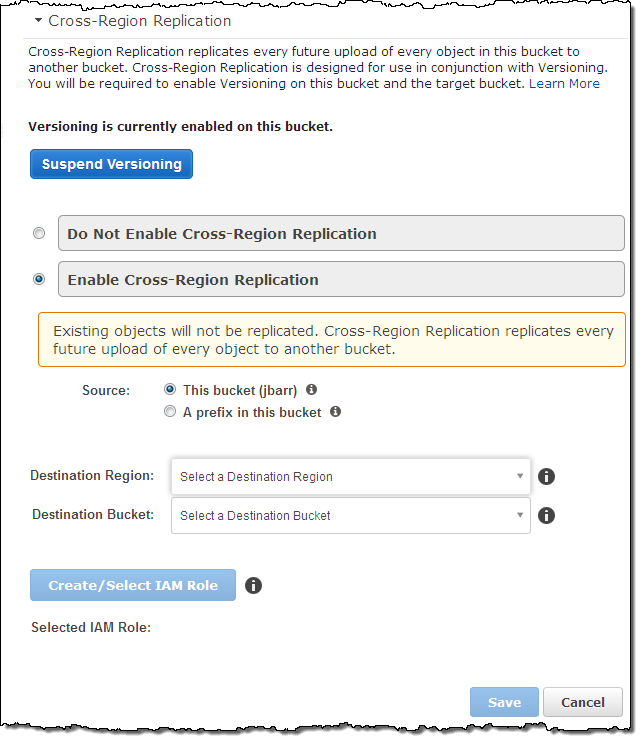
You can choose an existing bucket or you can create a new one as part of this step:
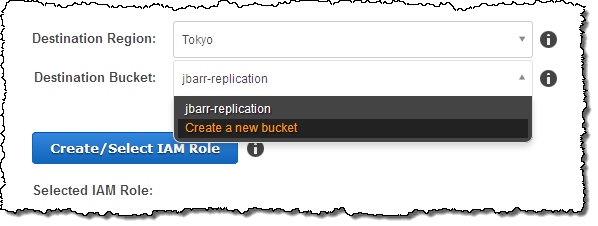
You will also need to set up an IAM role so that S3 can list and retrieve objects from the source bucket and to initiate replication operations on the destination bucket. Because you have the opportunity to control the policy document, you can easily implement advanced scenarios such as replication between buckets owned by separate AWS accounts. The console will help you to set up the proper IAM role by supplying a default policy:
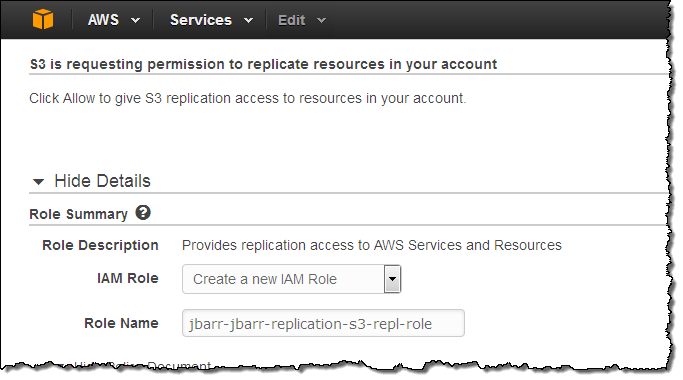
Once I had the replication all set up, I inspected the destination bucket. As expected, it was empty (replication works on newly created objects):
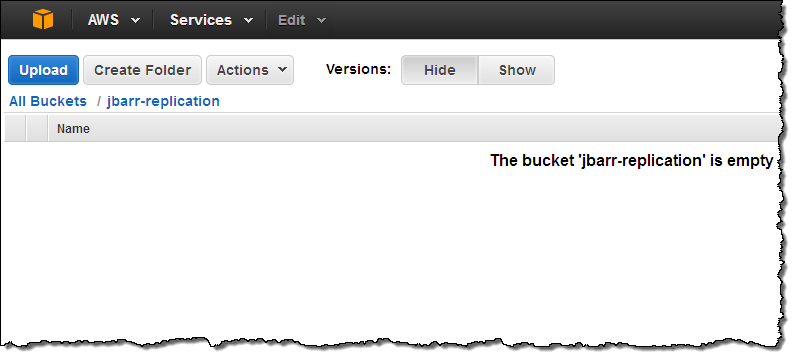
I uploaded a picture, and selected Reduced Redundancy Storage (RRS) and Server Side Encryption (SSE) using the AWS S3 master key:
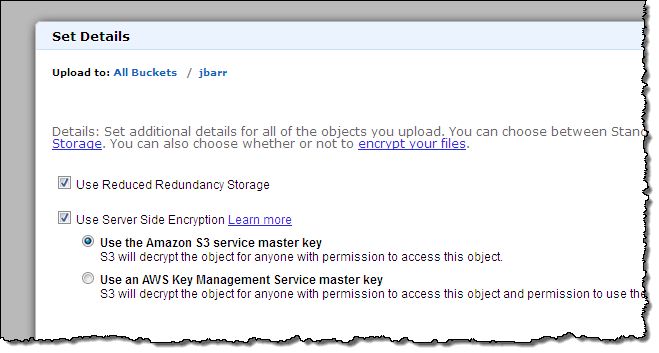
I refreshed my view of the destination bucket a couple of times (I’m impatient) and the object was there, as expected. I verified that the replica also used RRS and SSE:
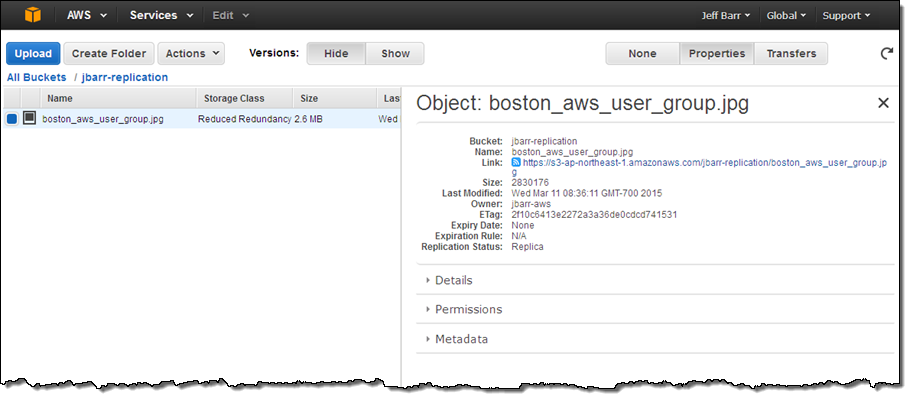
The replication process also copies any metadata and ACLs (Access Control Lists) associated with the object.
You can also enable and manage this feature through the S3 API.
A Few Details
“Based on the results of our testing, the S3 cross-region replication feature will enable FINRA to transfer large amounts of data in a far more automated, timely and cost effective manner. Making use of the new feature to help meet resiliency, compliance or DR data requirements is a no brainer.”
Peter Boyle, Senior Director
FINRA
Here are a few things to keep in mind as you start to think about how to make use of Cross-Region Replication in your own operating environment.
Versioning – As I mentioned earlier, you must first enable S3 versioning for the source and destination buckets.
Lifecycle Rules – You can choose to use Lifecyle Rules on the destination bucket to manage older versions by deleting them or migrating them to Amazon Glacier.
Determining Replication Status – You (or your code) can use the HEAD operation on a source object to determine its replication status. You can also (as you saw above) view this status in the Console.
Region-to-Region – Replication always takes place between a pair of AWS regions. You cannot use this feature to replicate content to two buckets that are in the same region.
New Objects – Because this feature watches the source bucket for changes, it replicates new objects and changes to existing objects. If you need to replicate existing objects, a solution built around the S3 COPY operation can be used to bring the destination bucket up to date.
To learn more, read about Cross-Region Replication in the S3 Developer Guide.
Available Now
This feature is available now and you can start using it today. In addition to the additional data storage charges for the data in the destination bucket, you will also pay the usual AWS price for data transfer between regions. For more information, please consult the S3 Pricing page.
— Jeff;
相關推薦
New – Cross-Region Replication for Amazon S3
We launched Amazon S3 nine years ago as of last week! Since that time we have added dozens of features, expanded across the globe, and red
New – VPC Endpoint for Amazon S3
I would like to tell you about a new AWS feature that will allow you to make even better use of Amazon Virtual Private Cloud and Amazon Simple Sto
AWS Dynamodb 跨區域遷移資料方案(cross-region replication)
最近實在受不了中國訪問AWS首爾區域了 ,決定把整個環境遷移到新加坡,伺服器遷移倒是比較簡單,但資料庫遷移遇到很大的麻煩。 原以為DynamoDB 全域性表可以很容解決跨區域資料同步的問題,結果發現DynamoDB全域性表只能在為空表的前提下使用,即必須是新建的表。而不能說 用到中途
Introducing support for Amazon S3 Select in the AWS SDK for PHP
We’re excited to announce support for the Amazon Simple Storage Service (Amazon S3) SelectObjectContent API with event streams in the AWS SDK for
New P2 Instance Type for Amazon EC2 – Up to 16 GPUs
I like to watch long-term technology and business trends and watch as they shape the products and services that I get to use and to write about. A
AWS Marketplace: Attunity CloudBeam for Amazon S3, EMR, Hadoop
Attunity CloudBeam for Amazon S3, EMR, Hadoop - Hourly
New – Server-Side Encryption for Amazon Simple Queue Service (SQS)
As one of the most venerable members of the AWS family of services, Amazon Simple Queue Service (SQS) is an essential part of many applications. P
New: Server-Side Encryption for Amazon Kinesis Streams
In this age of smart homes, big data, IoT devices, mobile phones, social networks, chatbots, and game consoles, streaming data scenarios are every
New – Your User Pools for Amazon Cognito
Amazon Cognito makes it easy for mobile and web apps to easily add authentication, user management, and data synchronization without having to wri
New – Amazon S3 Server Side Encryption for Data at Rest
A lot of technical tasks that seem simple in theory are often very complex to implement. For example, let’s say that you want to encrypt
Tutorial for building a Web Application with Amazon S3, Lambda, DynamoDB and API Gateway
Tutorial for building a Web Application with Amazon S3, Lambda, DynamoDB and API GatewayI recently attended Serverless Day at the AWS Loft in downtown San
New – Encryption of Data in Transit for Amazon EFS
Amazon Elastic File System was designed to be the file system of choice for cloud-native applications that require shared access to file-based sto
New – Encryption of Data at Rest for Amazon Elastic File System (EFS)
We launched Amazon Elastic File System in production form a little over a year ago (see Amazon Elastic File System – Production Ready in Three Reg
New – GPU-Powered Streaming Instances for Amazon AppStream 2.0
We launched Amazon AppStream 2.0 at re:Invent 2016. This application streaming service allows you to deliver Windows applications to a desktop bro
Amazon Athena – Interactive SQL Queries for Data in Amazon S3
The amount of data that we all have to deal with grows every day (I still keep a floppy disk or two around in order to remind myself that 1.44 MB
Test the Upload Speed of Amazon S3 Transfer Acceleration for a Specific File Size
Amazon Web Services is Hiring. Amazon Web Services (AWS) is a dynamic, growing business unit within Amazon.com. We are currently hiring So
New – Custom Metrics for Amazon CloudWatch
You can now store your business and application metrics in Amazon CloudWatch. You can view graphs, set alarms, and initiate automated actions bas

